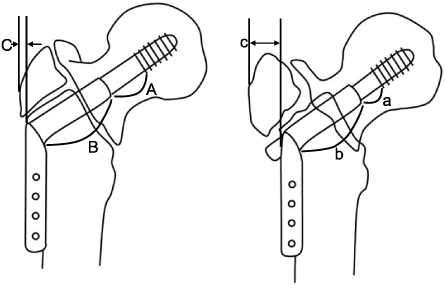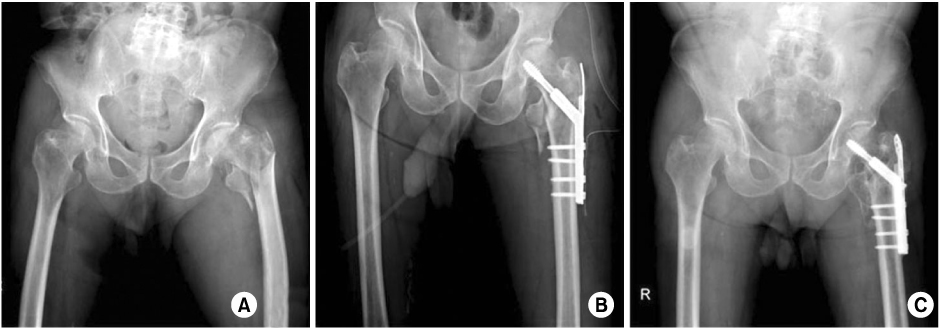J Korean Fract Soc.
2011 Oct;24(4):295-300.
Surgical Treatment of Femoral Unstable Intertrochanteric Fractures in Elderly Patients: Comparative Study between Compressive Hip Screws and Additional Trochanteric Stabilizing Plates
- Affiliations
-
- 1Department of Orthopaedic Surgery, Eulji University College of Medicine, Daejeon, Korea. yds123@eulji.ac.kr
Abstract
- PURPOSE
To evaluate the radiologic results between compressive hip screw and compressive hip screw with additional trochanteric stabilizing plate in patients with femoral unstable intertrochanteric fractures in patients with more 65 years old.
MATERIALS AND METHODS
From 2006 to May 2009, 121 cases were included. Group I (compressive hip screw only) was 54 cases and group II (compressive hip screw with trochanteric stabilizing plate) was 67 cases. We checked the lag screw sliding, lateral translation of greater trochanter, changes of neck-shaft angle and complications through periodic follow up of radiographs.
RESULTS
Mean lag screw sliding was 7.6 mm in group I and 3.9 mm in group II (p=0.001). Mean lateral translation of greater trochanter was 3.86 mm in group I and 0.59 mm in group II (p=0.01). Mean changes of neck-shaft angle was nearly the same, 3.57degrees in group I and 3.66degrees in group II. Complications were 15 cases in group I and 10 cases in group II.
CONCLUSION
Compressive hip screw with additional trochanteric stabilizing plate was effective surgical option in patients with femoral unstable intertrochanteric fractures in patients with more than 65 years old. It decreased lag screw sliding, lateral translation of greater trochanter and complication rates.
Figure
Reference
-
1. Aune AK, Ekeland A, Odegaard B, Grøgaard B, Alho A. Gamma nail vs compression screw for trochanteric femoral fractures. 15 reoperations in a prospective, randomized study of 378 patients. Acta Orthop Scand. 1994. 65:127–130.
Article2. Babst R, Renner N, Biedermann M, et al. Clinical results using the trochanter stabilizing plate (TSP): the modular extension of the dynamic hip screw (DHS) for internal fixation of selected unstable intertrochanteric fractures. J Orthop Trauma. 1998. 12:392–399.
Article3. Baumgaertner MR, Solberg BD. Awareness of tip-apex distance reduces failure of fixation of trochanteric fractures of the hip. J Bone Joint Surg Br. 1997. 79:969–971.
Article4. Buciuto R, Uhlin B, Hammerby S, Hammer R. RAB-plate vs Richards CHS plate for unstable trochanteric hip fractures. A randomized study of 233 patients with 1-year follow-up. Acta Orthop Scand. 1998. 69:25–28.
Article5. Davis TR, Sher JL, Horsman A, Simpson M, Porter BB, Checketts RG. Intertrochanteric femoral fractures. Mechanical failure after internal fixation. J Bone Joint Surg Br. 1990. 72:26–31.
Article6. Den Hartog BD, Bartal E, Cooke F. Treatment of the unstable intertrochanteric fracture. Effect of the placement of the screw, its angle of insertion, and osteotomy. J Bone Joint Surg Am. 1991. 73:726–733.
Article7. Doppelt SH. The sliding compression screw--today's best answer for stabilization of intertrochanteric hip fractures. Orthop Clin North Am. 1980. 11:507–523.
Article8. Forte ML, Virnig BA, Kane RL, et al. Geographic variation in device use for intertrochanteric hip fractures. J Bone Joint Surg Am. 2008. 90:691–699.
Article9. Gotfried Y. The lateral trochanteric wall a key element in the reconstruction of unstable pertrochanteric hip fractures. Clin Orthop Relat Res. 2004. (425):82–86.10. Haidukewych GJ. Intertrochanteric fractures: ten tips to improve results. J Bone Joint Surg Am. 2009. 91:712–719.11. Hardy DC, Descamps PY, Krallis P, et al. Use of an intramedullary hip-screw compared with a compression hip-screw with a plate for intertrochanteric femoral fractures. A prospective, randomized study of one hundred patients. J Bone Joint Surg Am. 1998. 80:618–630.
Article12. Im GI, Shin YW, Song YJ. Potentially unstable intertrochanteric fractures. J Orthop Trauma. 2005. 19:5–9.
Article13. Kang SY, Lee EW, Kang KS, et al. Mode of fixation failures of dynamic hip screw with tsp in the treatment of unstable proximal femur fracture: biomechanical analysis and a report of 3 cases. J Korean Orthop Assoc. 2006. 41:176–180.
Article14. Karunakar M, McLaurin TM, Morgan SJ, Egol KA. Improving outcomes after pertrochanteric hip fractures. Instr Course Lect. 2009. 58:91–104.15. Kim YC, An KC, Kim KY, et al. Treatment of osteoporotic unstable intertrochanteric fractures: comparative study between using dynamic hip screw and additional trochanter stabilizing plate. J Korean Orthop Assoc. 2005. 40:741–748.
Article16. Lee PC, Yu SW, Hsieh PH, Chuang TY, Tai CL, Shih CH. Treatment of early cut-out of a lag screw using a trochanter supporting plate: 11 consecutive patients with unstable intertrochanteric fractures. Arch Orthop Trauma Surg. 2004. 124:119–122.
Article17. Loch DA, Kyle RF, Bechtold JE, Kane M, Anderson K, Sherman RE. Forces required to initiate sliding in second-generation intramedullary nails. J Bone Joint Surg Am. 1998. 80:1626–1631.
Article18. Lunsjö K, Ceder L, Stigsson L, Hauggaard A. One-way compression along the femoral shaft with the Medoff sliding plate. The first European experience of 104 intertrochanteric fractures with a 1-year follow-up. Acta Orthop Scand. 1995. 66:343–346.
Article19. Madsen JE, Naess L, Aune AK, Alho A, Ekeland A, Strømsøe K. Dynamic hip screw with trochanteric stabilizing plate in the treatment of unstable proximal femoral fractures: a comparative study with the Gamma nail and compression hip screw. J Orthop Trauma. 1998. 12:241–248.
Article20. Medoff RJ, Maes K. A new device for the fixation of unstable pertrochanteric fractures of the hip. J Bone Joint Surg Am. 1991. 73:1192–1199.
Article21. Min BW, Lee KJ. Treatment of intertrochanteric fracture: dynamic hip screw. J Korean Fract Soc. 2009. 22:51–55.
Article22. Nakata K, Ohzono K, Hiroshima K, Toge K. Serial change of sliding in intertrochanteric femoral fractures treated with sliding screw system. Arch Orthop Trauma Surg. 1994. 113:276–280.
Article23. Palm H, Jacobsen S, Sonne-Holm S, Gebuhr P. Hip Fracture Study Group. Integrity of the lateral femoral wall in intertrochanteric hip fractures: an important predictor of a reoperation. J Bone Joint Surg Am. 2007. 89:470–475.
Article24. Park BC, Ihn JC, Kim SY, Ahn HS. Treatment of intertrochanteric fractures using gamma nail. J Korean Soc Fract. 1994. 7:588–596.
Article25. Park YS, Han KY, Kim HG. Effect of trochanter stabilizing plate in unstable intertrochanteric fracture. J Korean Soc Fract. 2000. 13:779–787.
Article26. Rha JD, Kim YH, Yoon SI, Park TS, Lee MH. Factors affecting sliding of the lag screw in intertrochanteric fractures. Int Orthop. 1993. 17:320–324.
Article27. Sadowski C, Lübbeke A, Saudan M, Riand N, Stern R, Hoffmeyer P. Treatment of reverse oblique and transverse intertrochanteric fractures with use of an intramedullary nail or a 95 degrees screw-plate: a prospective, randomized study. J Bone Joint Surg Am. 2002. 84-A:372–381.28. Yoshimine F, Latta LL, Milne EL. Sliding characteristics of compression hip screws in the intertrochanteric fracture: a clinical study. J Orthop Trauma. 1993. 7:348–353.
Article
- Full Text Links
- Actions
-
Cited
- CITED
-
- Close
- Share
- Similar articles
-
- The Neccessity of Additional Supporting Fixation for the Unstable Intertrochanteric Fractures of the Femur in the Elderly
- Treatment of Unstable Interochanteric Femoral Fracture using Compression Hip Screw with additional Transfixations Screw
- Treatment of Unstable Intertrochanteric Fracture Using Short Barrel Compression Hip Screws and a Trochanteric Stabilizing Plate
- Methods to Increase the Effectiveness of Trochanteric Stabilizing Plate for Unstable Femoral Intertrochanteric Fractures with Gtreater Trochanteric Fracture: Fixation of Greater Trochanter with Wire and Screw
- Treatment of Comminuted Trochanteric Fractures with Dynamic Hip Screw and DHS Trochanter Stabilizing Plate




